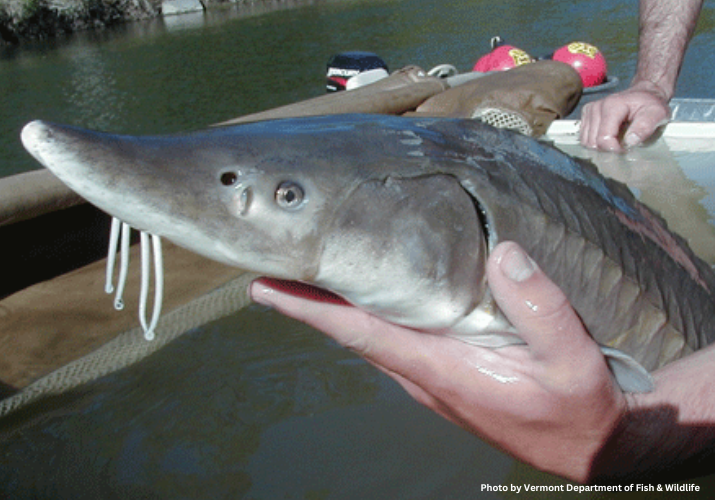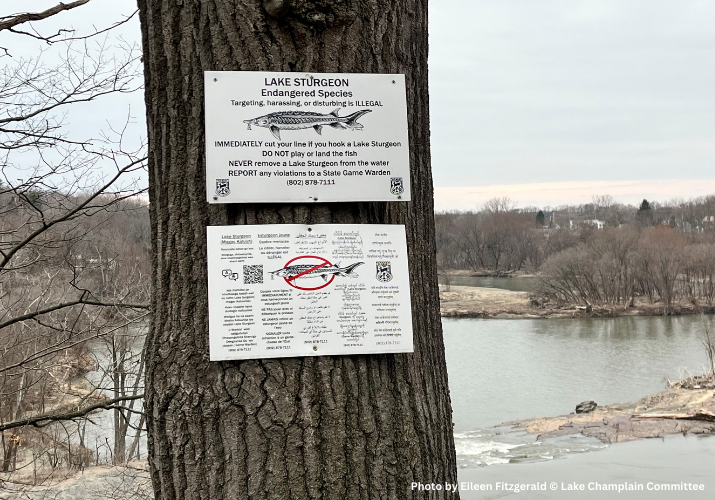Nature Note: Lake Champlain's Living Fossil
LCC Summer's End 2024 E-News
Lake sturgeon are fish with a lot of superlatives. They have been on Earth longer than any flowering plant, can grow to the standing height of an adult man, and live to be supercentenarians in the right conditions. Lake sturgeon have complicated relationships with people—they were nearly driven to extinction and are currently designated as endangered in Vermont and threatened in New York.
Lake sturgeon are the longest living and the largest fish in Lake Champlain. The oldest individuals have been chronicled to reach 150 years in age. That means there may be fish in the lake that have been alive for longer than women could vote in the US (a fact both admirable for fish and depressing for human rights). This longevity slows their reproductive habits—males reach sexual maturity at around eight to15 years of age and females between 14 and 33 years. They spawn infrequently--each year only 10 to 20% of adult sturgeon breed. The largest lake sturgeon grow to about seven feet in length and weigh 200-300 pounds. But the average adult lake sturgeon are roughly four to six feet long and 30-80 pounds.

Lake sturgeon are bottom dwellers and generally prefer deeper, larger bodies of water and spawn in shallower areas by shore. They’re found both in Lake Champlain as well as some of its tributaries, where they tend to reproduce. Sturgeon have long, cone-shaped snouts and mouths set back on the underside of their bodies, and they sense their way through their environment with four barbels, or whisker-like protrusions from the front of their snouts that have taste buds and are attuned to sense nearby prey.
Lake sturgeon have been referred to as “living fossils”. Their existence on Earth dates to the Mesozoic era about 150 million years ago when dinosaurs roamed. The fossil record that puts lake sturgeon back this far indicates that their biology is almost entirely the same as it was when they first appeared. They sport some “vintage” features that harken to the early evolutionary days of fish: their skeletons are comprised of flexible cartilage rather than bone and they have notochords, which are antecedents to the spinal column. These are both traits they share with sharks, another ancient fish.
Lake sturgeon have a varied relationship with humans and given their biological stagnation for the past 150 million years, this reflects shifting cultural attitudes rather than changes in the fish. In the early 19th century, lake sturgeon were frequently considered a nuisance. It was common for them to be caught in traps set for more commercially valuable fish due to their large size and tendency to spawn close to shore. Sturgeon were thusly scorned by most anglers and were typically killed and dumped back into the water or fed to pigs.
This all changed later in the 19th century when Americans and Canadians began to prize lake sturgeon—not for their ecological or inherent value, but for their meat, caviar, and isinglass (a high-quality gelatin derived from their bladders). While there is no precise record of the amount of sturgeon in the lake prior to the sturgeon fad, we know that small commercial fishing operations harvested up to 200 individuals per year.
In the late 1940’s, annual harvests dropped dramatically. The overfishing combined with the degradation of their native habitats, the damming of spawning grounds, and sea lamprey wounding took a toll on lake sturgeon. Vermont declared lake sturgeon endangered in 1972 and New York designated them as a threatened species in 1983.
With long lifespans and slow reproduction, conservation efforts have not yielded a fast turnaround for Lake Champlain sturgeon populations, but there are signs of improvement. Biologists with Vermont Fish and Wildlife have reported a gradual increase in lake sturgeon since 1999 when surveying of spawning tributaries began. It’s not enough information to estimate total lake populations, nor is it necessarily indicative of a comeback, but it’s not a population crash.

These ancient fish live on in Lake Champlain, but their health and longevity hang in the balance of conservation policy and human behavior. In the spring of 2024, Senator Peter Welch (D-Vt.) introduced a resolution to recognize the importance of lake sturgeon in Lake Champlain and freshwater systems across the country. The resolution encourages Congress to support sturgeon protection efforts through habitat restoration and improved monitoring. However, in the same week, the Center of Biological Diversity’s petition filed in May 2018 asking the U.S. Fish and Wildlife Service to list lake sturgeon as endangered or threatened on a national level was rejected. This means that legal harvesting of the fish can continue in states lacking endangered protections, such as Wisconsin and Michigan.
While the national success of sturgeon protection is a mixed bag, the state laws in New York and Vermont prohibit sturgeon fishing. Anglers should follow these tips:
Don’t bring the fish out of the water if possible. Being out of the water puts further stress on them.
Use pliers to remove the hook; sturgeon are almost always hooked in the mouth.
Support the fish horizontally. Don't hold sturgeon in a vertical position by their head, gills, or tails. Avoid bending its jaw or spine at an unnatural angle.
Hold larger fish with two hands to keep the weight of the fish from damaging its bones or internal organs. Keep one hand behind the gill plate and the other under the fish’s belly.
Never touch their eyes or gills. These are highly sensitive areas for the fish and can easily be damaged with handling.
Minimize their time out of the water and return them to the water immediately once they are freed from fishing gear.
The true value of these ancient fish—beyond the economic worth for which they were prized in the past—is starting to be realized, and with effective policy and responsible fishing practices, we can support lake sturgeon’s recovery in Lake Champlain.
